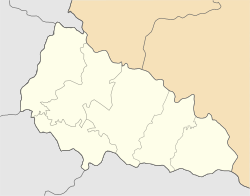Zolotarovo (Ukrainian: Золотарьово, Hungarian: Ötvösfalva, German: Solotarjowo), Czech: Zlatary is a village located in the Khust Raion of Zakarpattia Oblast (province) of western Ukraine.
Zolotarovo
Золотарьово Ötvösfalva | |
|---|---|
Village | |
 View of Zolotarovo | |
| Coordinates: 48°10′51″N 23°30′06″E / 48.18083°N 23.50167°E | |
| Country | |
| Oblast | |
| Raion | Khust Raion |
| Founded | 1616[1] |
| Government | |
| • Mayor | Ivan Mikhailovich Babich |
| Elevation | 319 m (1,047 ft) |
| Population (2001) | |
| • Total | 4,226 |
| Time zone | UTC+1 (CET) |
| • Summer (DST) | UTC+2 (CEST) |
| Postal code | 90441 |
| Area code | +380-3142 |
The population at the 2001 census was 4,266 people.[2] The village is governed by a council. The head of the council is Ivan Mikhailovich Babich.[3]
The village used to have a fruit factory.[4]
Zolotarovo has been twinned with Newport-on-Tay since 2002.[5][6]
Name
editAccording to one legend, the first goldsmiths in the village were good masters, made various dishes from the plates, and hammered for weaving. They also performed carpentry and blacksmithing works, for which they were called "goldsmiths", which means they had "golden hands".[7]
History
editThe first written mention of the village dates was 1616. This was described by a village teacher Omelyan Belinsky in 1938 in his historical chronicle of the village. He wrote, "It is spread over the picturesque multi-level landscapes of the gray smoky Carpathians: hills, valleys, hills and many streams. In spring it sinks in apple-pink-white flowers, in summer—in a fabulous variety of Carpathian flowers, in autumn—in delicious, aromatic fruits of apples – ferkovani, and in winter the same apple-trees, shrouded in silver frost and white dazzling snow."[8] It has been historically an ethnically Rusyn village.[9]
During the time that the area was part of Kingdom of Hungary, the village was located in the district of Huszt, Máramaros County.[10]
World War II
editOn March 15, 1939, as part of the occupation of Transcarpathia by Nazi Hungary, the Hungarian army entered the village. Mass arrests and interrogations of citizens. Nearly 80 people left the village in the fall of 1939 and in 1940 and crossed the border into the Soviet Union through a pass in the village of Synevyrska Polyana to seek refuge. Some were captured by Hungarian army and returned home. And those who managed to cross the border were caught on the other side.[7]
In April 1944 Jews of Zolotarovo were deported to the ghetto in nearby Khust prior to being deported them to Auschwitz at the end of May.[11][12]
Churches
editThere are four churches in the area around Zolotarovo.
The oldest is the Greek Catholic Church at the northeast side of the village.[13] The Greek Catholic Church of John the Baptist Cathedral was founded in 1865. Inside is a painting of "The Last Supper", the work of an Italian master, and four icons: Jesus Christ, Blessed Virgin Mary, St. St. Nicholas the Wonderworker and St. John the Baptist, as well as a picturesque iconostasis with "royal gates" and images of archangels, apostles and other saints. A bell tower was built near the church. Not far from the temple is a church lighthouse (built in 1863) and a chapel (built in 1860). The lighthouse was erected for the priests' residence and for the educational activities of the children. In Soviet times it was used as a school and as a hostel for children from remote parts of the village. The chapel was erected at the expense of goldsmiths who worked in America. At the request of the wage earners, five crosses of hewn stone were made for the remnants of these funds.[8]
A newer Russian Orthodox church is near the center of the village on a side road.
Notable people
edit- Vasyl Mykhailovych Dovhovych (1783–1849) – historian, priest [14]
- Oleksandr Slyvka (1909–2008) – author of the Khust National Theater[15], [7]
Gallery
editReferences
edit- ^ В ужгородському видавництві "Ґражда" побачила світ "Історія села Золотарьово" (ФОТО) ["History of the village of Zolotaryovo" was published in the Uzhhorod publishing house "Grazhda" (PHOTO)].
- ^ "Офіційний портал Верховної Ради України".
- ^ ЗОЛОТАРІВСЬКА СІЛЬСЬКА РАДА [Zolotarovo Village Council].
- ^ "Zolotarovo (Zolotarovo, Zolotarjovo)". 29 December 2008.
- ^ "Fifedirect - Tourist information". Archived from the original on 3 January 2017. Retrieved 17 October 2018.
- ^ "Home". nazta.co.uk.
- ^ a b c Natalia Gaidur (2011). The History of the Village of Zolotarovo. Uzhhorod Publishing House Grazhd.
- ^ a b "Khust District State Administration".
- ^ "Národopisná mapa Uher podle úredního lexikonu osad z. R. 1773... / Prof. A. Petrov". 1924.
- ^ Hungarian Institute of Cartography and Geoinformatics. "1910 Austro-Hungarian Monarchy".
- ^ "Kereső".
- ^ Lists and Registers of German Concentration Camp Inmates, 1946 - 1958, File: Record Group: 242. College Park, Maryland: The National Archives at College Park.
- ^ Gaidur, Natalia (2015). The History of the Zolotarovo Greek Catholic Church. Ukraine: Uzhhorod Publishing House Grazhda. ISBN 978-966-176-076-8.
- ^ Carpatho-Rusyn American (PDF), 1983, retrieved 14 October 2022
- ^ "Олександр Сливка".
- Gaidur, Natalia (2011). The History of the Village of Zolotarovo. Ukraine: Uzhhorod Publishing House Grazhda.
- Gaidur, Natalia (2015). The History of the Zolotarovo Greek Catholic Church. Ukraine: Uzhhorod Publishing House Grazhda. ISBN 978-966-176-076-8.

